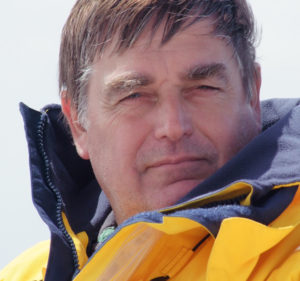 Bob Comlay is a veteran of two Tilman expeditions to Greenland, and has cajoled many sailors, climbers and writers into contributing forewords and afterwords to our new Collected Edition of Tilman, shedding fresh light on a frequently misunderstood figure:
Bob Comlay is a veteran of two Tilman expeditions to Greenland, and has cajoled many sailors, climbers and writers into contributing forewords and afterwords to our new Collected Edition of Tilman, shedding fresh light on a frequently misunderstood figure:
I first met Bill Tilman when I was seventeen; he was seventy-one, old enough to be my grandfather. By the time I was half way through my nineteenth year, I’d made two voyages north, sailing more than 10,000 miles and spending just over eight months at sea with him, ‘taking the rough with the smooth’, to quote his own stated requirement of me.
Over the course of his sailing career, Tilman took on over one hundred different crew members. Those with a background of mountaineering or the army were taken on trust – their loyalty under pressure and respect for his leadership never in doubt, even if their fitness for small boat voyages at times left something to be desired. The remainder of the crews were selected through advertisements placed in suitable journals, typically in the personal column of The Times. These notices were often deliberately worded along the lines of Hands wanted for long voyage in small boat. No pay, no prospects, not much pleasure – in order to weed out the chaff. The mixed bunch of applicants that resulted included a number of young people like myself, the kind that we would probably now loosely term ‘gap year’ candidates.
The destinations were remote, the ocean passages followed little-travelled courses and we sailed without lifejackets, safety lines or life rafts. GPS locator beacons had yet to be invented and would, in any event, have been of little or no use; for much of the voyage, Tilman’s boats were hundreds of miles beyond the normal range of rescue teams. While this might now appear foolhardy, his attitude to safety was proactive, wherever possible taking sensible measures to avoid getting into danger rather than taking uncalculated risks with either boat or crew. Those calculations owed more to mountaineering, where the consequence of risk is obvious, than sailing.
Thirty years later I loaded a few of my old Kodachrome images onto a simple website along with a few pages of text and a contact form, and a regular trickle of incoming emails demonstrated the remarkable global reach of the Tilman story. In 2008, one contact from the organisers of the Three Peaks Yacht Race invited me to give an illustrated talk at a Tilman Festival in Barmouth. It was a couple of years after that event that a member of its audience, Dick Wynne, traditional east coast sailor and the enthusiastic workaholic behind Lodestar Books, contacted me with a proposal to ‘republish Tilman’. Key to getting the project off the ground was gaining the approval of the copyright holder, something that I was happy to be able to facilitate. Another couple of years passed by before our occasional conversations led to a joint venture being formed between Lodestar and Vertebrate Publishing, the specialist climbing publisher based in Sheffield which owned the Tilman publishing rights. The publication schedule was set for sixteen volumes in a new edition – seven mountaineering books, eight sailing books and a reprint of J.R.L. Anderson’s biography – to appear quarterly in pairs between 2015 and 2017.
The new editions contain new forewords, and in many cases afterwords, from travellers and writers who either knew Tilman or who are well qualified to comment. Sir Robin Knox-Johnston and his erstwhile Greenland sailing and climbing partner Sir Chris Bonington were the first to sign up to the project, and a terrific selection of contributors have followed suit.
Sir Robin set the standard with six pages on his fellow ‘old boy’ from Berkhamsted School:
I have never been sure whether Tilman was particularly hard on his crews or he just chose them badly. Such comments about a crew member as ‘felt that a man with the unseamanlike habit of wearing gloves at night in summer in the Atlantic would not prosper on a voyage of this kind’ indicate a rather unsympathetic attitude toward his crew’s comfort, even if one might share his surprise.
Roger (Ming Ming) Taylor makes some sharp observations on Tilman’s qualities:
Tilman’s books are the nearest I get to having a permanent bedside companion. They’re never far away. Sometimes I read them cover to cover, other times I browse and dip. Tilman is endlessly fascinating and infuriating too. His adventures serve as both inspiration and warning. He is a guiding light and a hero, yet riddled with flaws and contradictions.
The more I read Tilman, the more I am convinced that his attitude to the proximity of land was not as well-honed or cautious as it should have been. His boats were neither the quickest nor the most close-winded, nor were their engines particularly reliable, yet time and again he stands in close, often, it seems, just for the hell of it.
Fellow high latitude sailor Skip Novak echoes Roger’s sentiments:
The Tilman stories are re-read on a regular basis, not only for amusement but by way of reminding ourselves of our fallibility (mistakes are still made) and for the wisdom of not taking ourselves too seriously. Some ships carry the Bible, we carry Tilman, a continuous source of inspiration and entertainment.
From the perspective of a modern yachtsman who is now dependent on a variety of gadgets, and in view of so many near misses experienced by Tilman and his crews, you can understand how recent generations might discredit his methods at sea, some of which may, with hindsight, have been suspect.
It should be little surprise that some of the respondents to Tilman’s cryptic crew notices included young women to whom polite letters of refusal had to be written. Much ill-informed nonsense has been written about Tilman’s attitude to women and it was appropriate that the new edition offered a right to reply.
Janet Verasanso, the ‘Grace Darling’ of Mischief in Patagonia, and probably the only woman ever to sail with Tilman, has broken her silence after sixty years to give her own forthright perspective on the encounter. Her contribution offers a unique first-hand perspective which is surprisingly gracious in its conclusion:
In retrospect it seems almost incredible that Tilman, who was so inept in the yard and on the voyage to Gibraltar, had within a matter of months become a true sailor, fearlessly mastering the intricacies of traditional ocean navigation and deep-sea sailing. He remains a colossus among the many heroes of the twentieth century, whose laconic sense of humour and wit lay deeply buried in his day-to-day life, but was brought out most amusingly in excellent and frequently very frank books, which once started are difficult to put down.
Annie Hill, whose Voyaging on a Small Income remains an inspiration to many, is an enthusiastic fan:
For anyone who has read about H. W. Tilman, he might seem an unlikely inspiration for a young feminist and pacifist. Admittedly, I was given Mischief in Patagonia to read by someone who admired him without reservation, but I have read other books, equally recommended, without acquiring a life-long hero.
Elsewhere in her piece Annie offers her own experience in defence of some of Tilman’s perceived failings:
Greenland charts are generally devoid of soundings and details and one mountain looks very much like another. Interpreting charts is a skill that can’t be learnt in a few weeks, and often there was no-one on board to help Tilman work out what he was looking at. Try doing this sort of pilotage yourself, before muttering that Tilman wasn’t all he could have been. That he made mistakes was only to be expected.
The new editions also contain previously unpublished views of those who actually sailed before the mast under Tilman’s leadership. Colin Putt, a veteran of the remarkable Heard Island voyage of 1964–65, who also sailed with me to West Greenland in 1970, knew Tilman better than most:
Sometimes he failed to notice uncomfortable conditions which others saw as hardships, but in congenial company he could be the life and soul of the party and he was always concerned and caring to his friends, although a little shy with strangers. He did have a horror of commercialisation of adventure, any attempt to involve him in such would turn him away, so would any suggestion that his volunteer crews should be paid or that he should install a two-way radio with which to cry for help and rescue. People who had tried to open these ideas with him may well have left with an impression of a laconic recluse, for he was too polite to enter into argument with them.
Tilman not only learned to sail, navigate and command late in life, but he was also largely self-taught. When he did get himself into trouble at sea he was remarkably good at fighting his way out of it and, like Shackleton, never lost a crew member through any fault of his own.
Contributions from the mountaineering community to the new Tilman edition reflect on the impact and importance of his climbing past. Steve Bell, just one example, pays eloquent tribute to an early pioneer of Himalayan climbing:
It is perhaps a kindness that the taciturn and ascetic Bill Tilman is no longer here to see the circus that Everest has become; his angels might weep indeed. But we must remember that whatever the future holds for the world’s highest mountain, it will never diminish the mighty endeavours of its earliest explorers.
I have long felt privileged to have had the opportunity to ‘take the rough with the smooth’. With hindsight, knowing that we sailed at the very end of an era about to be extinguished by technological advances only serves to underline that privilege.
Sir Robin sums that point up in his foreword to Mischief in Patagonia:
The arrival of GPS has closed forever the heroic era of expedition travel, whether on land or at sea. It has deprived the modern sailor of the satisfaction of making a good landfall by use of the sextant or dead reckoning, and of the hours spent nervously watching out for a landfall in thick fog with just a lead line to indicate a possible position. So it is perhaps hard for the sailors of today to imagine the extra care and doubt that were a part of the navigator’s lot until the 1980s. Tilman’s voyages have to be seen in the light of small elderly boats, reaching out to Polar areas infrequently visited and not accurately charted, and with crews of varied experience, and without any of the modern aids that are now taken for granted.
It is a part of his restless character that Tilman actively sought the unfrequented areas of the world. He relished the opportunity to explore, and the dangers that are inevitable to the pathfinder just brought added spice to his life. That Tilman completed so many of his voyages successfully is a credit to his determination and his seamanship.
Roger Taylor comes close to capturing my own recollection of the character of the Skipper:
In a sense his achievements are all the greater for his persistence in the face of constant set-backs: broken spars, blown-out sails, sprung planks, deserting crew and so on. He was no youngster either, when coping with all of this. Perhaps that’s one of my favourite aspects of his tales: his indomitable, bloody-minded refusal to give up. But more than that, I come back again and again for the pure quality of his writing – witty, erudite, understated, self-deprecating. There was a lot more to him than the allegedly misogynistic old curmudgeon of popular portrayal. He was a complex man and a deep thinker. Even in the moments of greatest despair, as everything goes wrong for him, one senses that he is looking at it all with a twinkle in his eye.
And leaving the last word to Annie Hill:
Bill Tilman inspired me, not so much because of what he chose to do, but because of the way in which he did it: quietly, without fanfare, understated, but with a profound sense of joy in his ventures and with a deep appreciation of the sublime beauty of remote places. The fact that he came home and wrote about them to share with others is the greatest of gifts. His books are classics that should be in print as long as men and women climb mountains and sail the seas.
Dick Wynne’s original intention had a commendable aim – to keep Tilman in print. In reality, it’s gone far beyond that. Now the series is complete, we have added much to the record through the worthy contributions of a number of significant voices, all of whom have been influenced directly or indirectly by Tilman himself.

